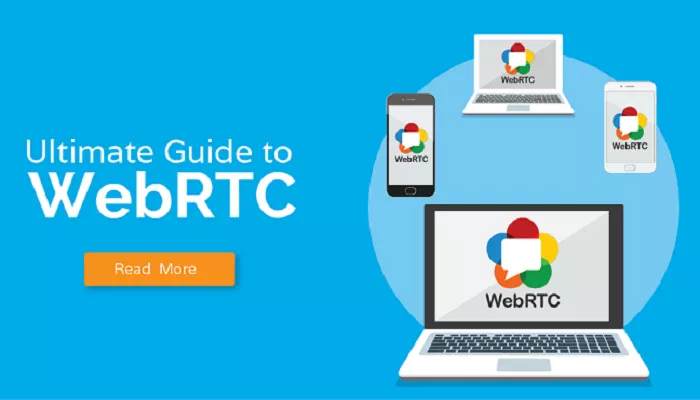In today’s digital age, real-time communication is essential. Whether it’s a video call with a colleague, a voice chat with a friend, or sharing files instantly, we rely on seamless communication tools. One technology that powers many of these interactions is WebRTC.
WebRTC stands for Web Real-Time Communication. It’s an open-source project that enables real-time communication between web browsers and mobile applications using simple application programming interfaces (APIs). With WebRTC, developers can easily incorporate voice calling, video chat, and data sharing capabilities into their websites and applications, without the need for plugins or third-party software .
This guide will explore what WebRTC is, how it works, its benefits, applications, and its future in 2025.
What is WebRTC?
WebRTC is a free and open-source project that provides web browsers and mobile applications with real-time communication capabilities via APIs. It allows audio and video communication and streaming to work inside web pages by allowing direct peer-to-peer communication, eliminating the need to install plugins or download native apps .
Supported by major tech companies like Apple, Google, Microsoft, Mozilla, and Opera, WebRTC specifications have been published by the World Wide Web Consortium (W3C) and the Internet Engineering Task Force (IETF) .
How Does WebRTC Work?
WebRTC operates on the peer-to-peer principle, meaning that communication occurs directly between users’ devices, bypassing central servers whenever possible. This allows for faster, more efficient data transfer and reduces the dependency on network infrastructure .
The key components of WebRTC are:
- MediaStream API: This API allows access to a user’s audio and video streams, enabling the capture and processing of media in real-time.
- RTCPeerConnection: This API establishes a connection between two or more devices, enabling direct communication without the need for intermediate servers. It handles NAT traversal, encryption, and media codec negotiation.
- RTCDataChannel: This API enables low-latency, bidirectional communication of arbitrary data between browsers or applications. It is commonly used for file sharing, text chat, and other data-intensive applications.
Benefits of WebRTC
- No Plugins Required: WebRTC operates natively in modern web browsers, eliminating the need for users to install additional plugins or software.
- High-Quality Audio and Video: WebRTC supports high-definition audio and video, ensuring clear and reliable communication.
- Low Latency: The peer-to-peer nature of WebRTC reduces latency, resulting in real-time communication with minimal delay.
- Secure Communication: WebRTC uses encryption to ensure that all data transmitted between peers is secure.
- Cross-Platform Compatibility: WebRTC works across various platforms, including desktops, smartphones, and tablets, making it versatile for different use cases.
Applications of WebRTC
WebRTC has a wide range of applications across various industries:
- Video Conferencing: Platforms like Zoom and Google Meet leverage WebRTC for real-time video communication.
- Customer Support: Businesses use WebRTC to provide live chat and video support to customers directly through their websites.
- File Sharing: WebRTC enables direct peer-to-peer file sharing without the need for intermediary servers.
- Online Education: Educational platforms use WebRTC to facilitate live classes and interactive learning experiences.
- Gaming: Real-time multiplayer games utilize WebRTC for in-game communication between players.
WebRTC in 2025: Future Trends
As we move further into 2025, WebRTC continues to evolve and integrate with emerging technologies:
- AI and Machine Learning Integration: WebRTC is incorporating AI and machine learning to enhance features like noise cancellation, real-time language translation, and adaptive video quality based on network conditions .
- IoT Connectivity: WebRTC is being used to enable real-time communication between Internet of Things (IoT) devices, facilitating smarter homes and industries.
- Augmented and Virtual Reality: WebRTC is playing a role in delivering immersive AR and VR experiences over the web, enabling applications like virtual meetings and remote assistance.
- 5G Networks: The rollout of 5G networks is enhancing the capabilities of WebRTC, providing higher bandwidth and lower latency for real-time communication.
Security Considerations
While WebRTC offers robust security features, it’s essential to be aware of potential vulnerabilities:
- IP Address Leaks: In some cases, WebRTC can expose a user’s local IP address, even when using a VPN. This can be mitigated by disabling WebRTC in the browser settings or using browser extensions that block WebRTC leaks.
- Encryption: WebRTC uses encryption to secure data transmitted between peers. However, it’s crucial to ensure that all endpoints support and enforce encryption standards.
Conclusion
WebRTC has revolutionized real-time communication on the web, providing developers with powerful tools to create seamless and secure applications. As technology continues to advance, WebRTC’s role in enabling real-time communication across various platforms and devices will only grow, shaping the future of digital interaction.

